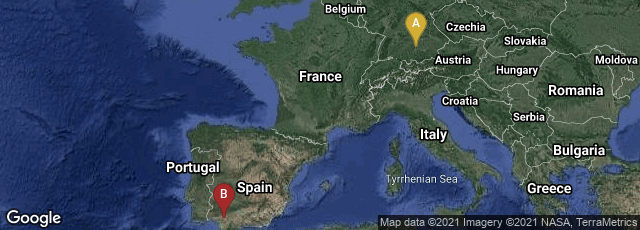
A: Augsburg-Innenstadt, Augsburg, Bayern, Germany, B: Sevilla, Andalucía, Spain
On November 19, 1472 printer Gunther Zainer of Augsburg, Germany, issued the Etymologiae of archbishop Isidore of Seville. A medieval encyclopedia written in the seventh century, it contained a simple diagramatic world map in the so-called "T-O" style. This woodcut has been called the first map included in a printed book. It depicts the continent of Asia as peopled by descendants of Sem or Shem, Africa by descendants of Ham, and Europe by descendants of Japheth, the sons of Noah.
"Isidore taught in the Etymologiae that the Earth was round "resembl[ing] a wheel". This is the same description used by the early Greek philosopher Anaximander for the sun before any spherical ideas emerged. Most writers think he referred to a disc-shaped Earth though some believe that he considered the Earth to be globular. He did not admit the possibility of people dwelling at the antipodes, considering them as legendary and noting that there was no evidence for their existence. Isidore's round map, which is essentially that of Anaximander, continued to be used through the Middle Ages by authors such as the 9th century bishop Rabanus Maurus who compared the habitable part of the northern hemisphere (Aristotle's northern temperate clime) with a wheel.
"In Book III he says 'At the same time [the sun] rises it appears equally to a person in the east as a person in the west', implying that it is flat. But for north and south he follows works such as the Topographia Christiana saying the earth is raised up towards the northern region and declines to the south. The fact that Sysebut uses the word globus meaning a sphere, in a letter to Isidore, whereas Isidore sticks to the word orbis, meaning circle or disk, confirms this" (Wikipedia article on Etymologiae, accessed 06-04-2011).
ISTC no. ii00181000. In November 2013 a digital facsimile was available from the Bayerische Staatsbibliothek at this link.